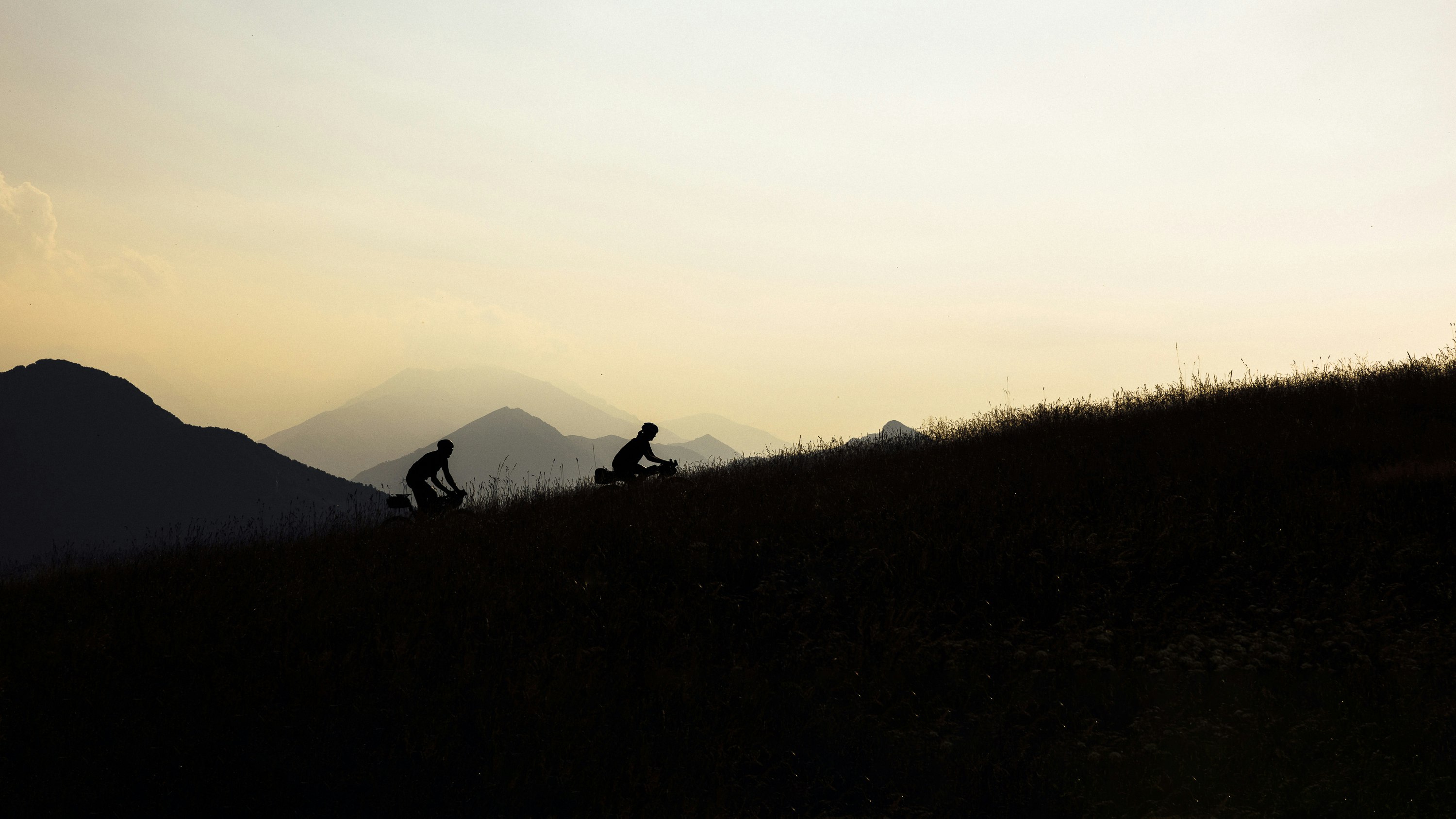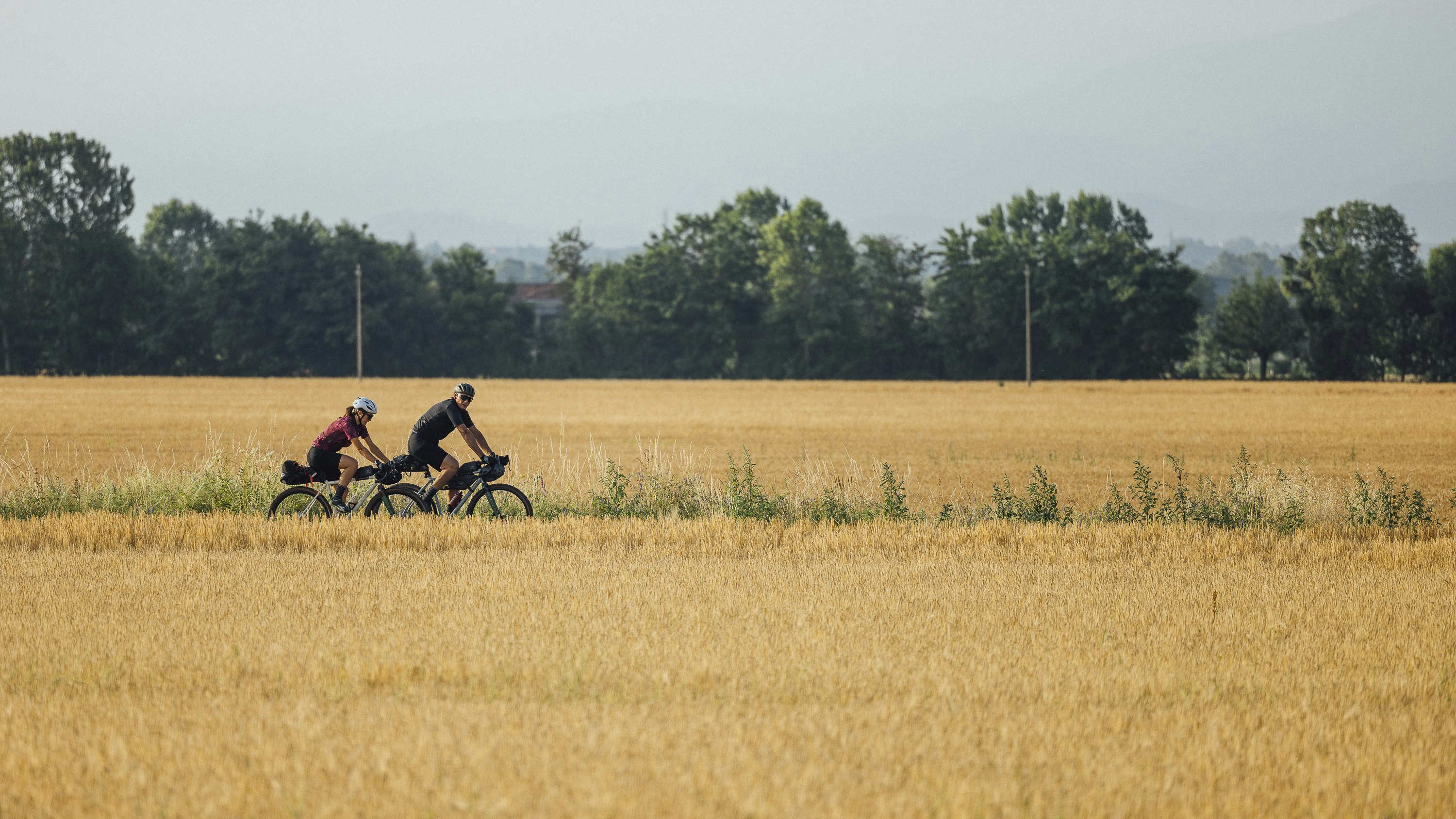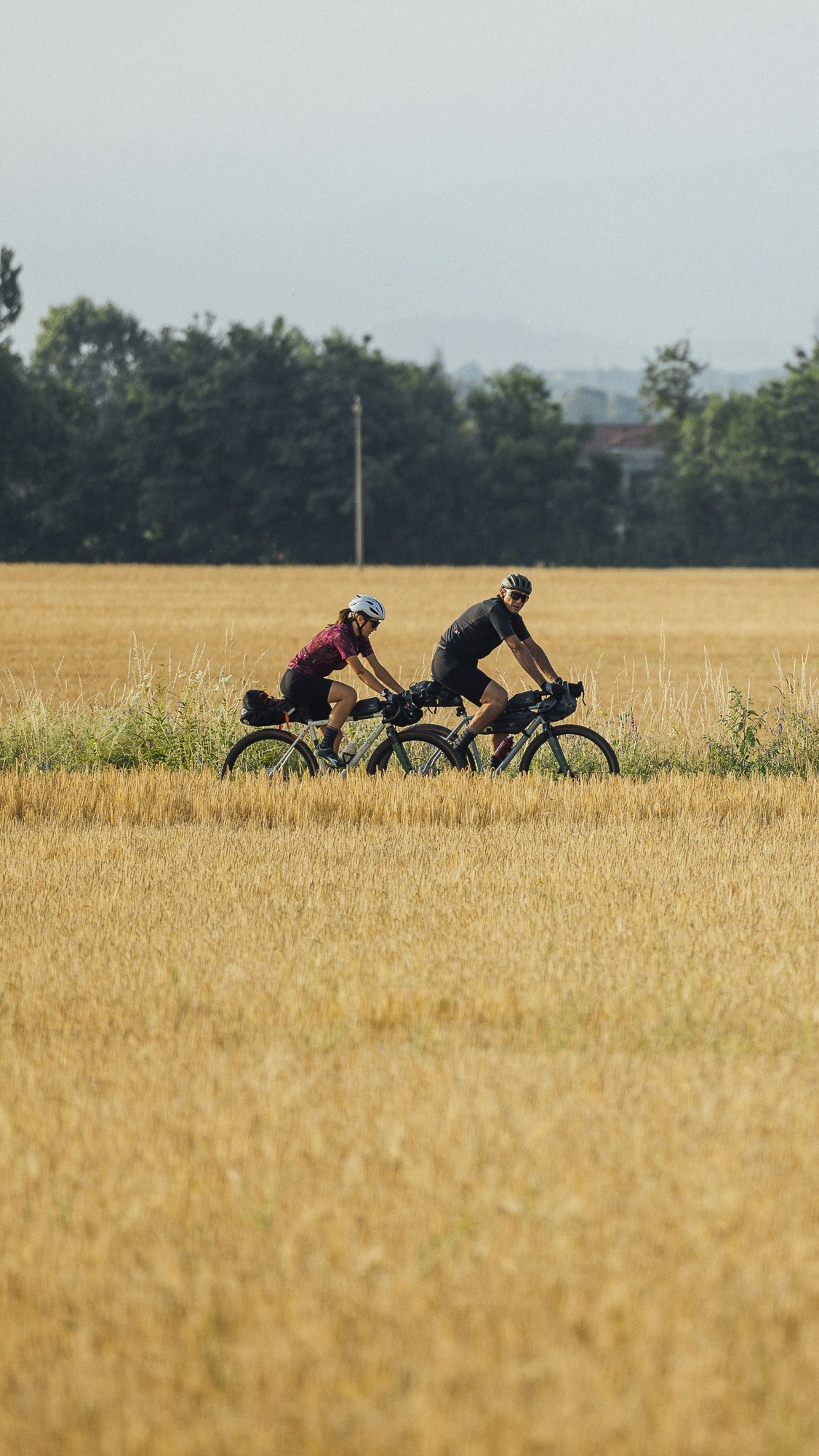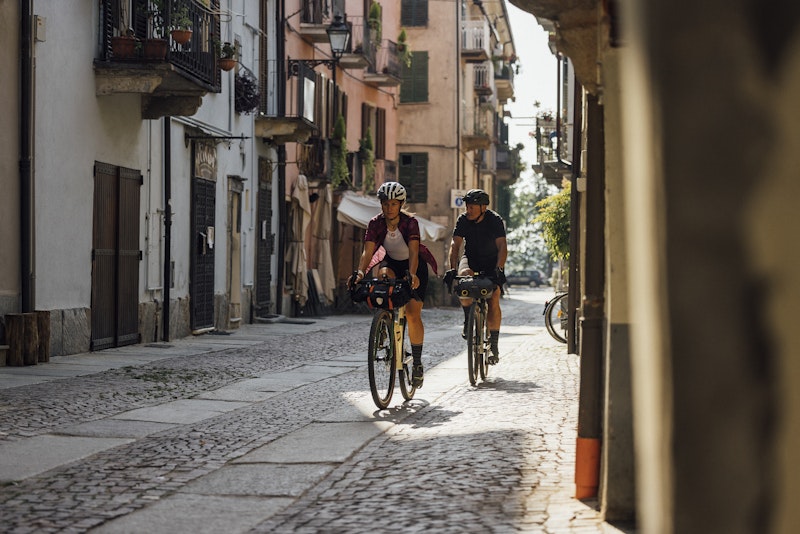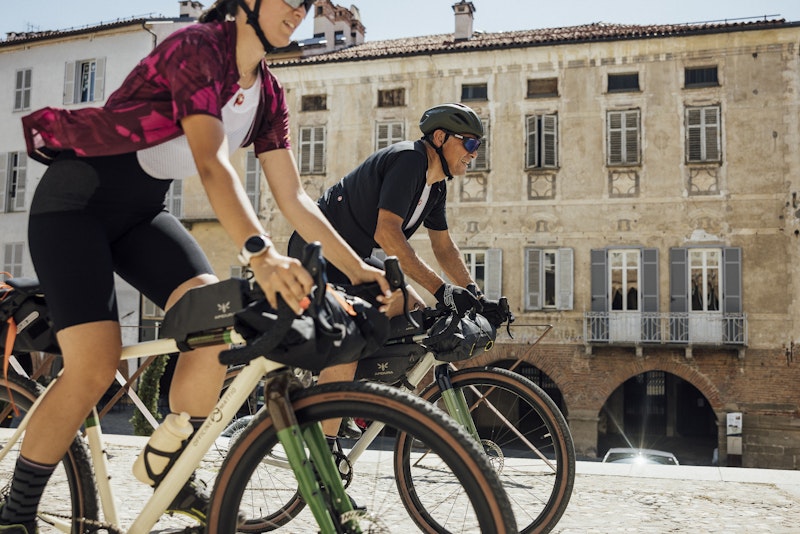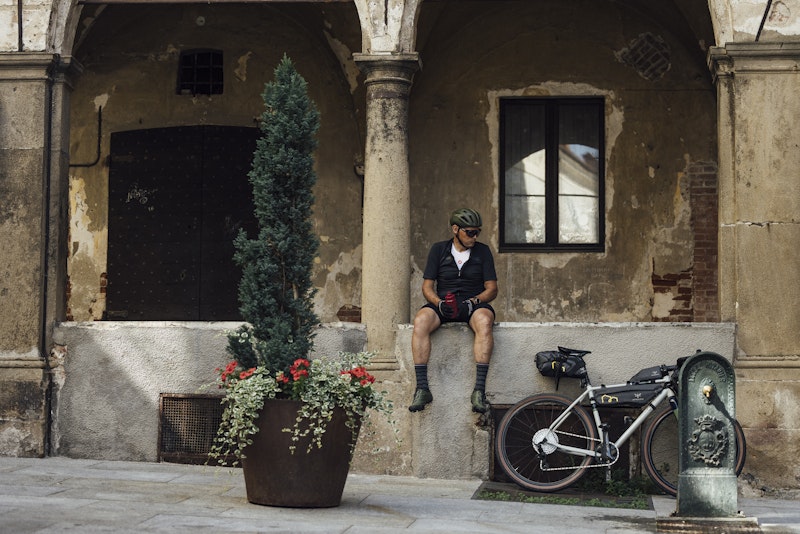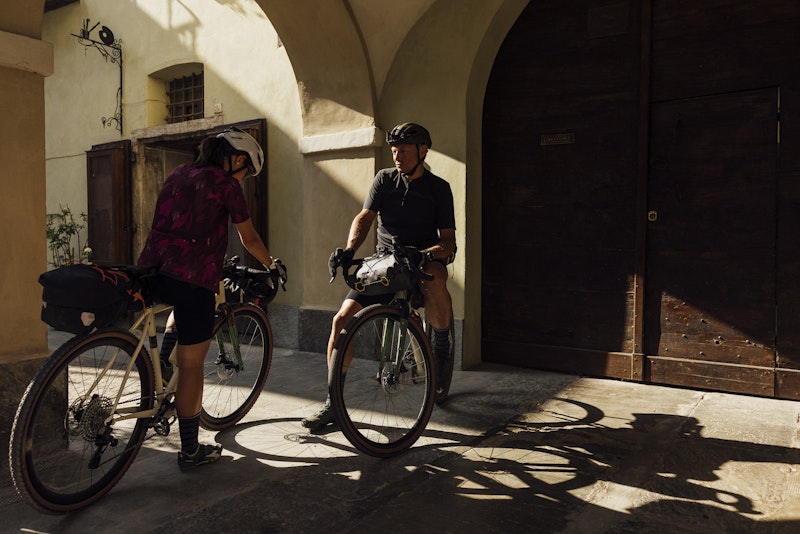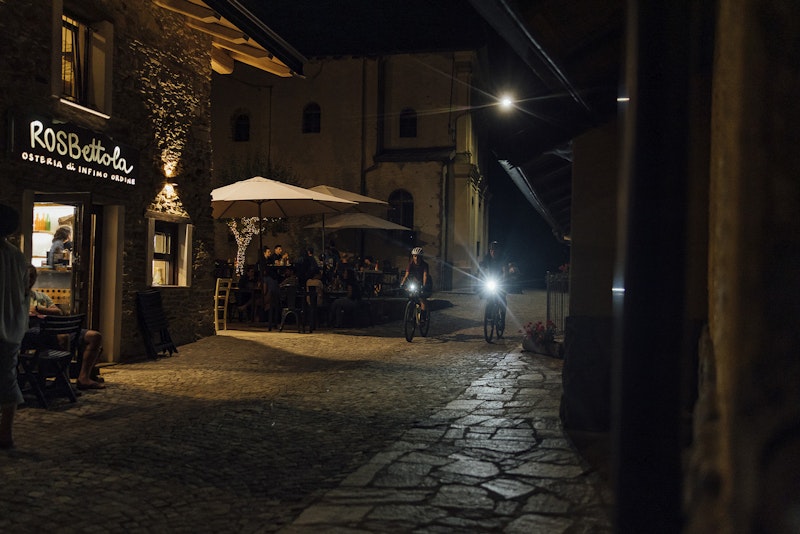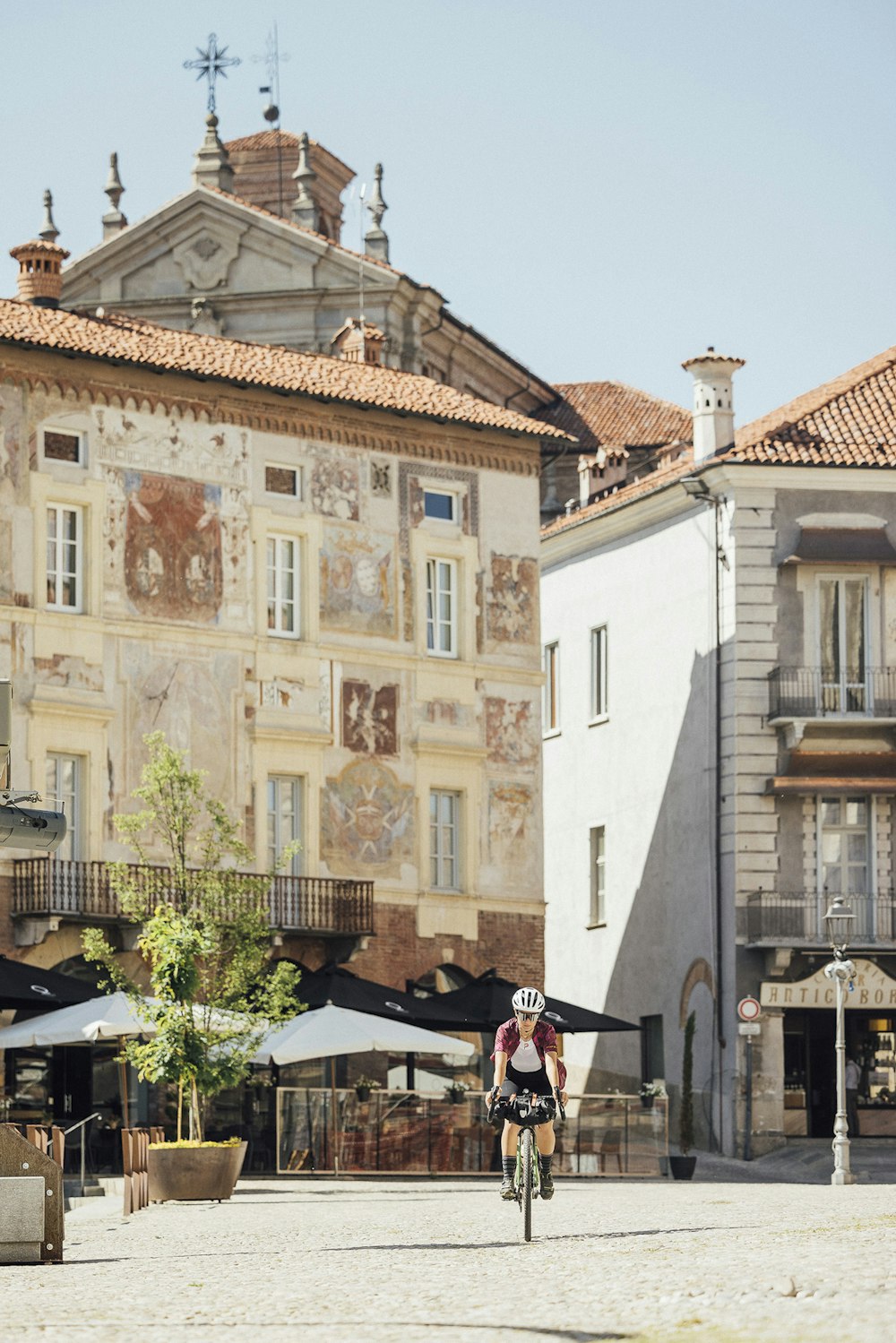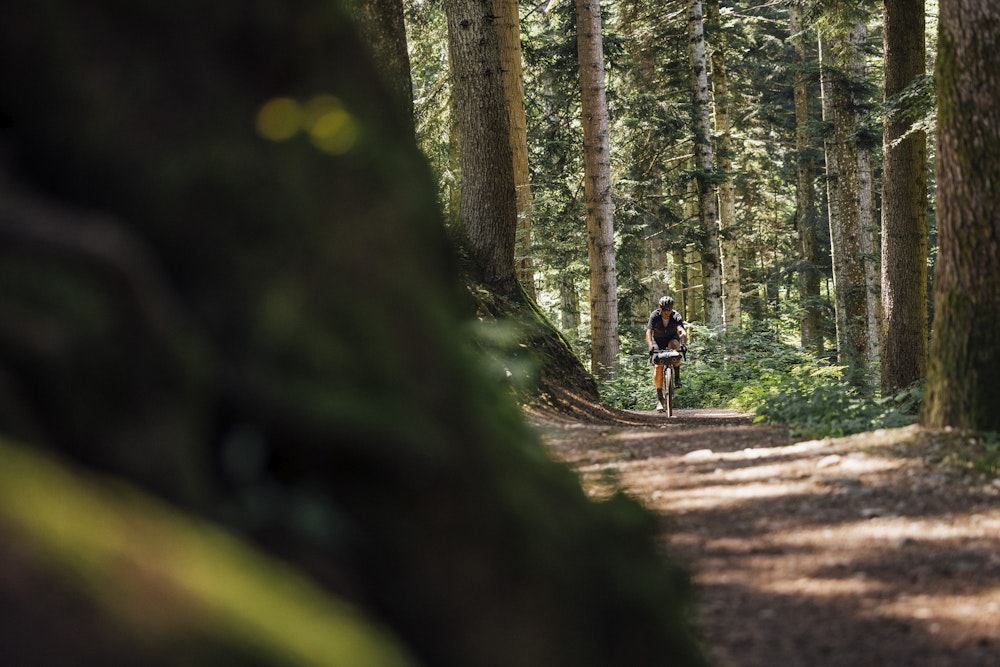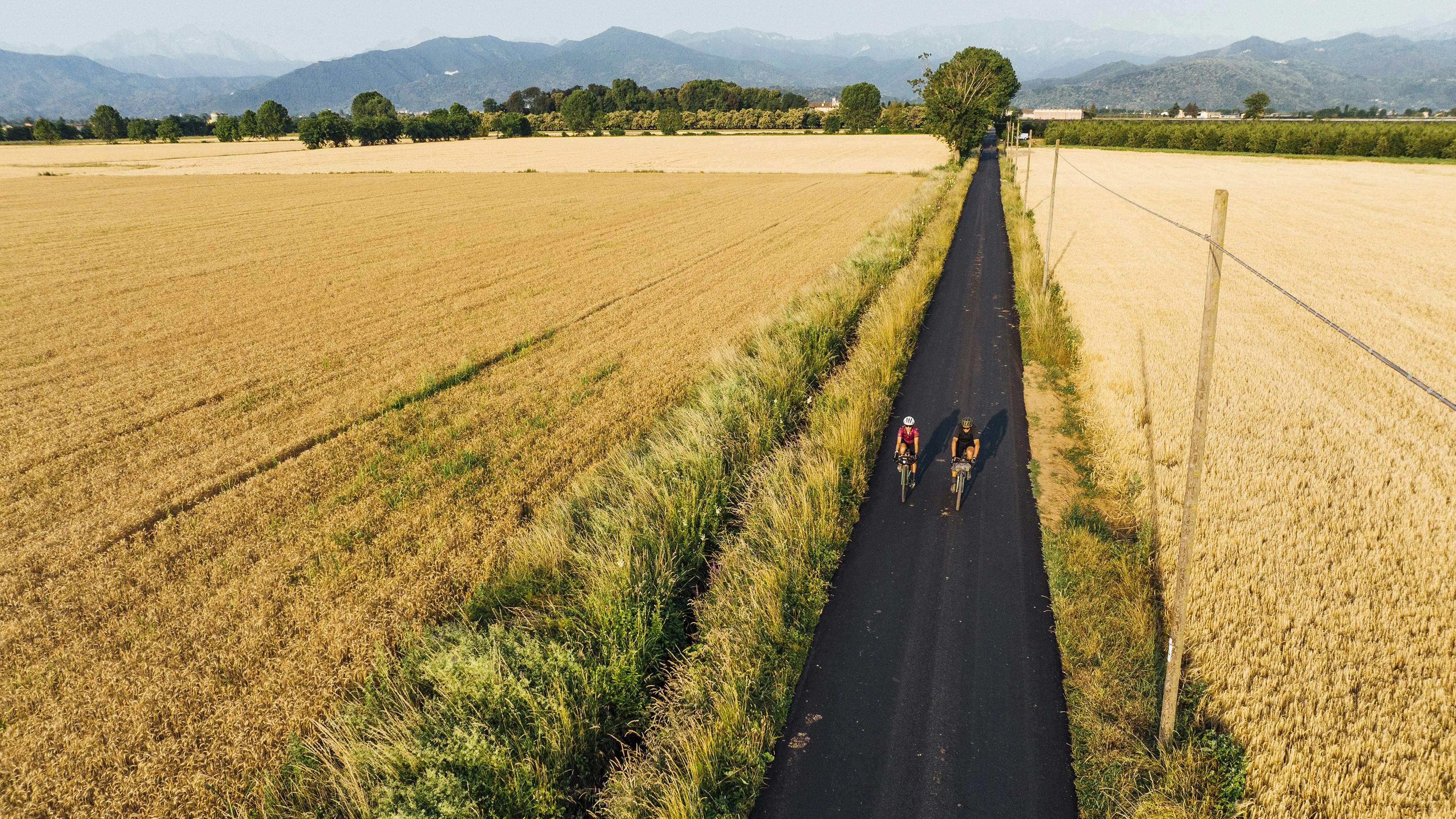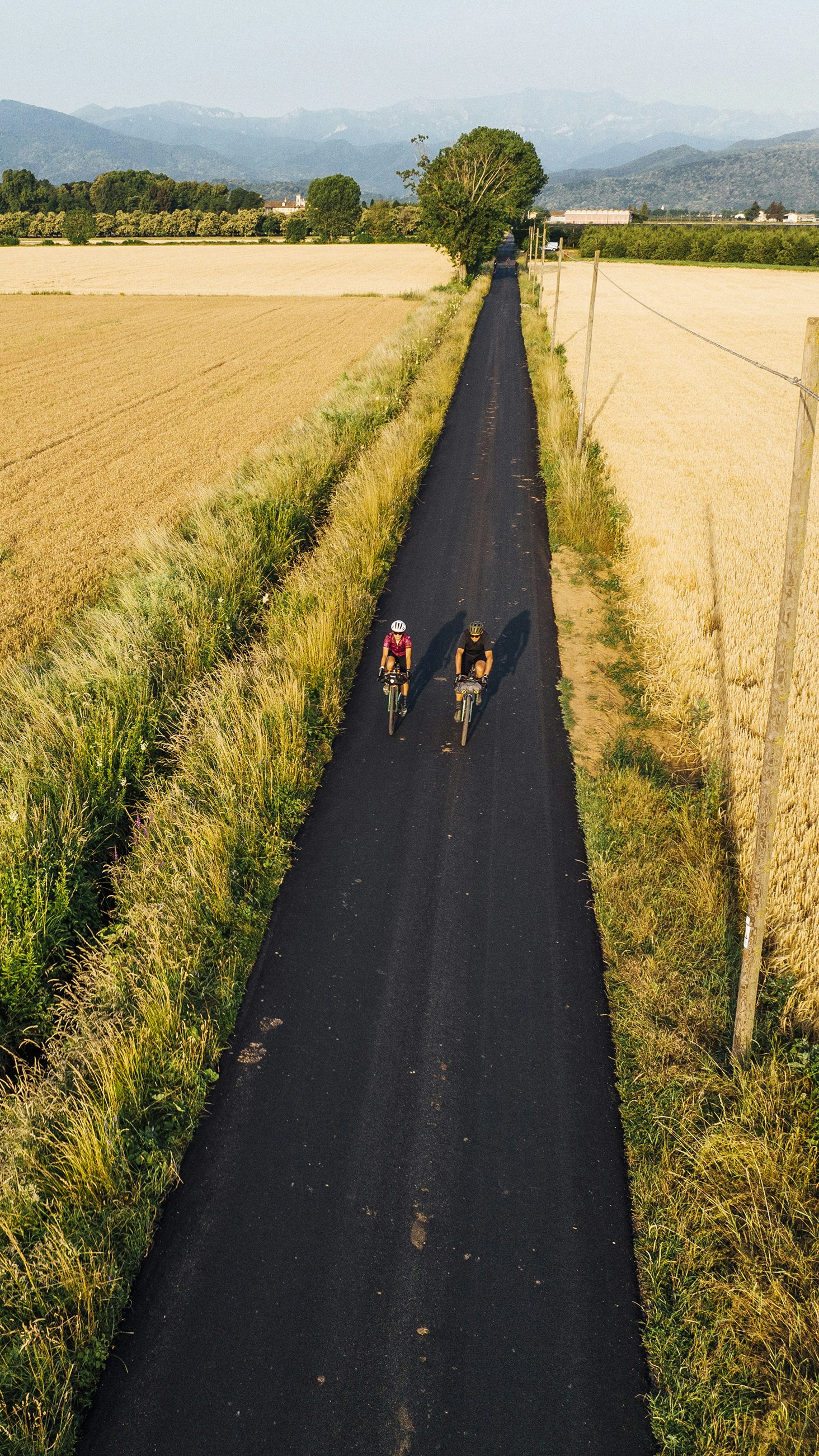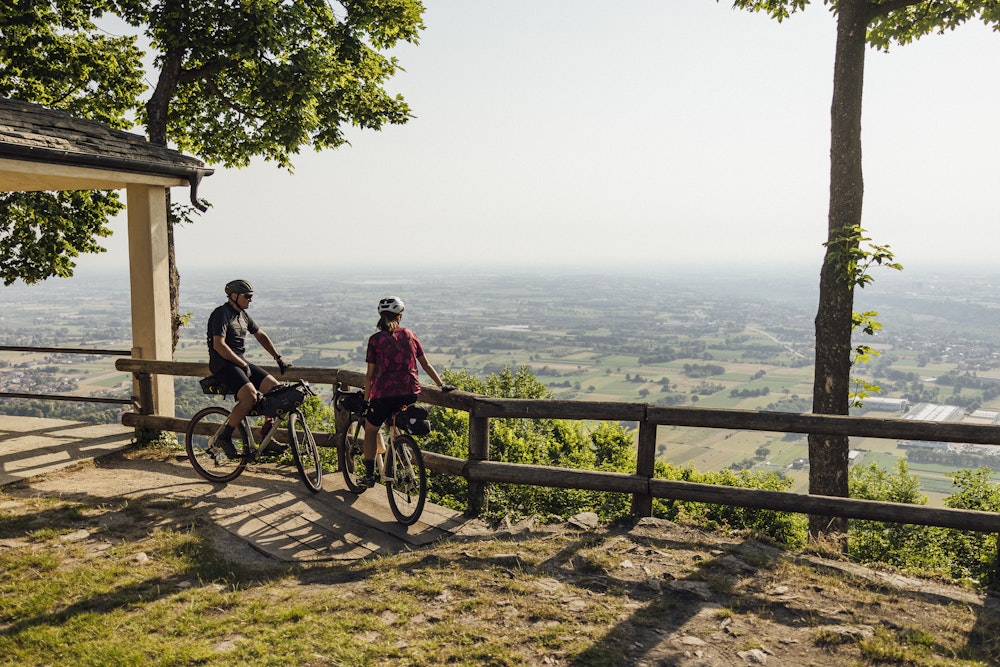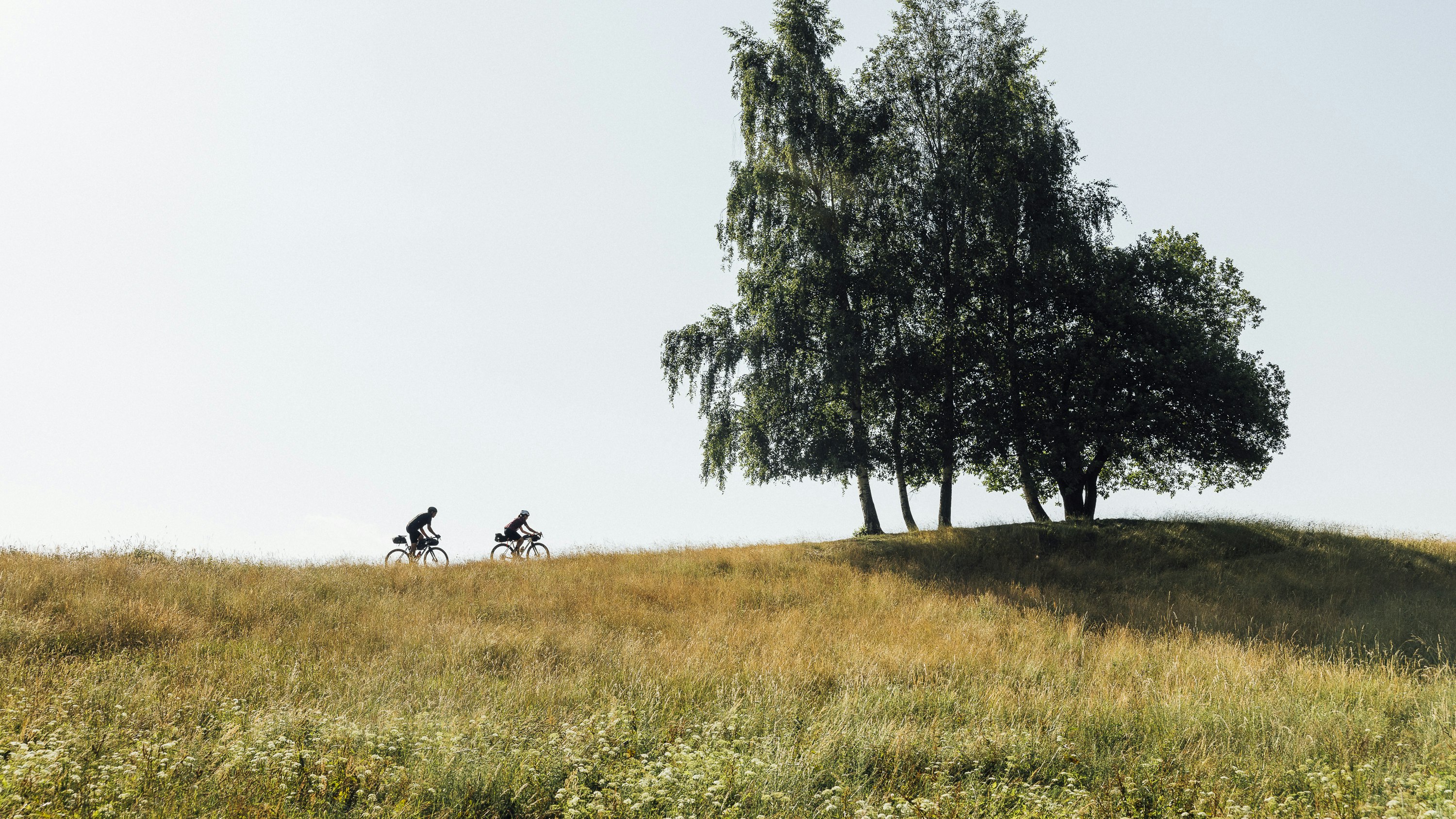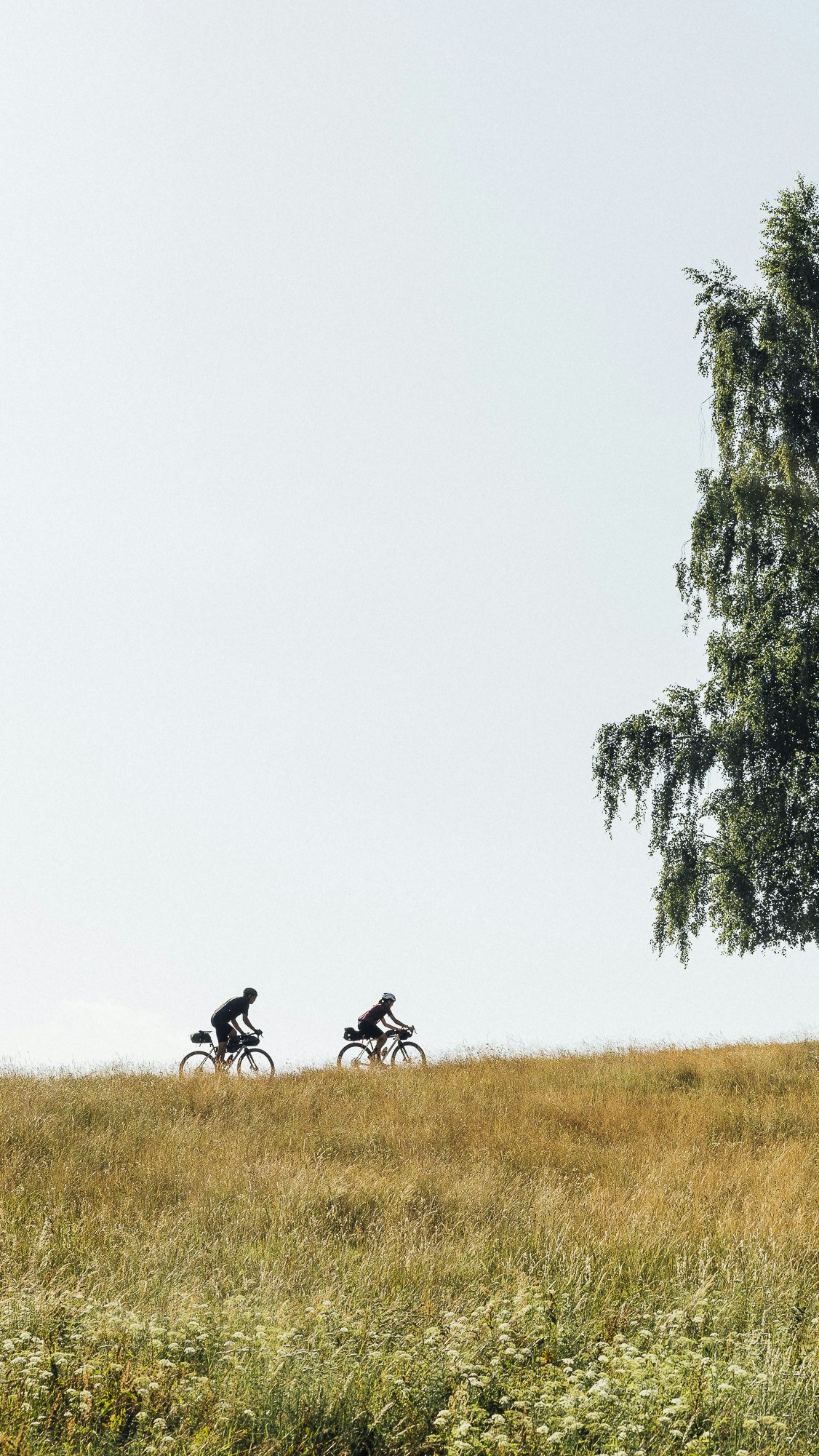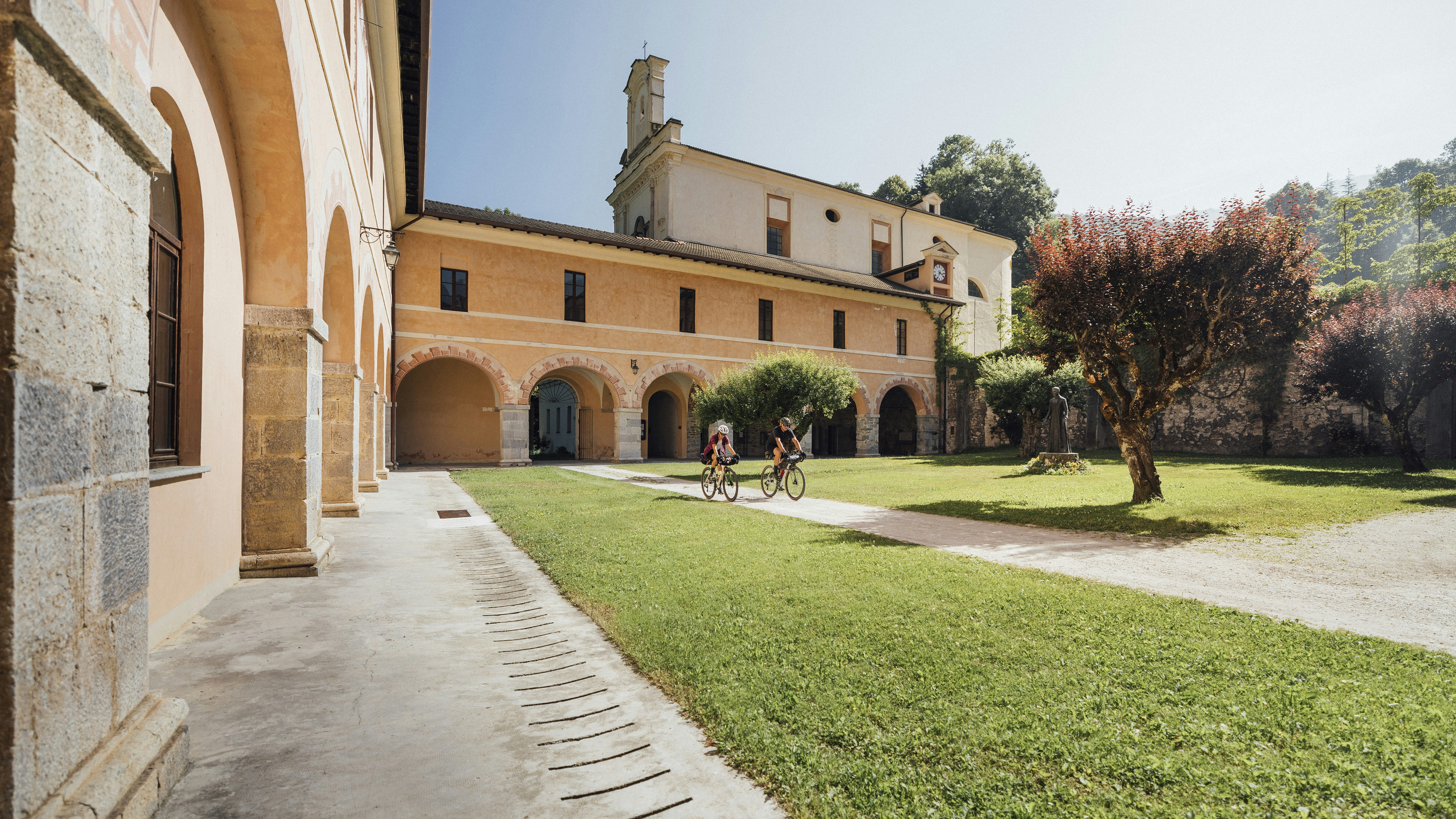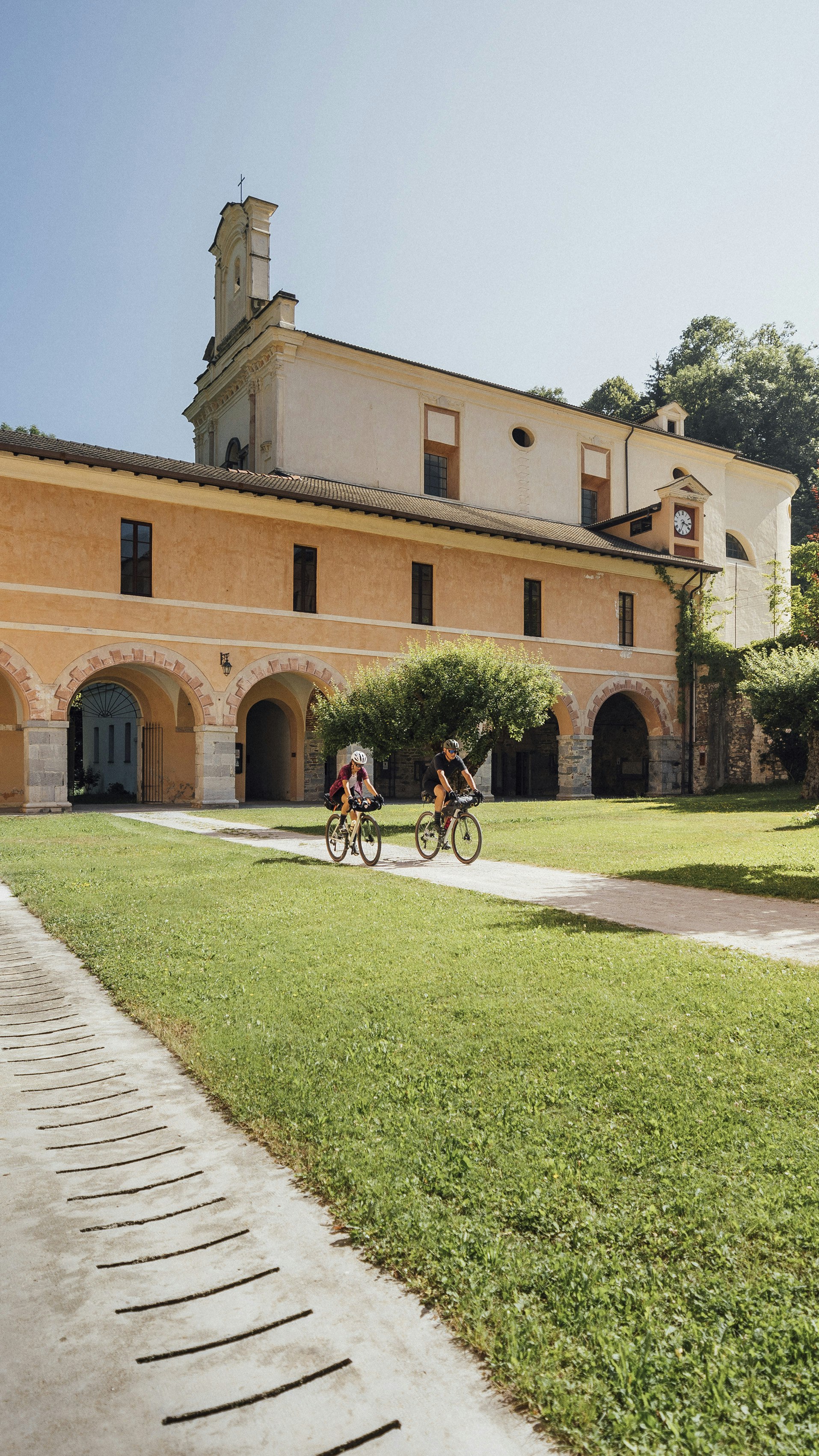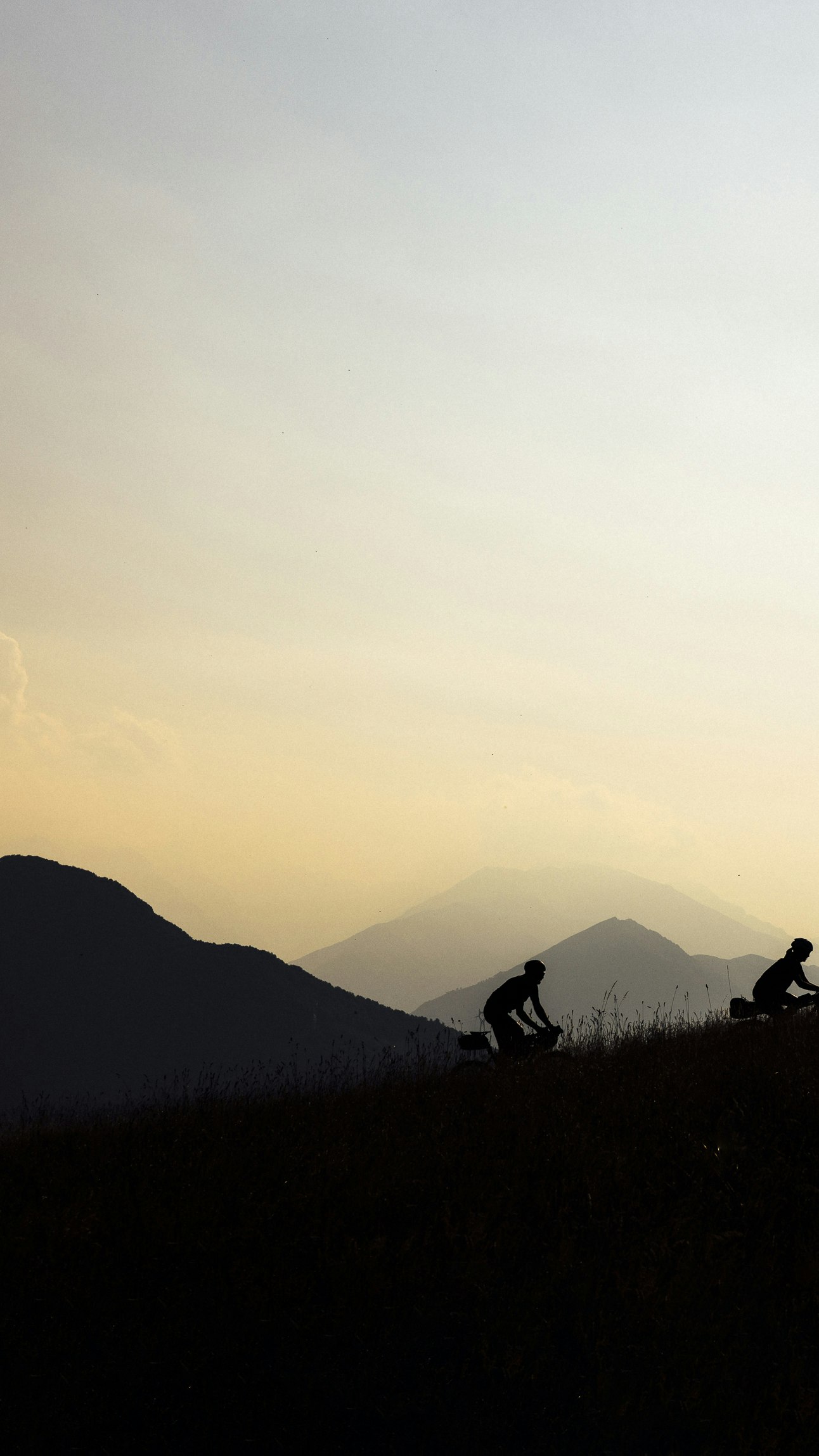
Pedalata Granda
Discovering the foothills surrounding the city of Cuneo. 330 kilometres in the shadow of the great mountains.
Elevation difference
5384 m
Total Length
330 km
Duration
4 Days
O
Pedalata Granda
00
Intro
01
From Cuneo to Dronero: at the foot of the valleys
02
Small and big discoveries between Gesso and Stura
03
Up and down the valleys
04
From Certosa di Pesio to Mondovì and back to Cuneo
At the first light of dawn, the silence and shadows of the night still envelop Via Roma. We brush past the bar tables on the pavement, still there in their places, while the daytime bustle is a distant fantasy. Our only company is a garbage truck leaving for the early shift. A glance at the bikes and bikepacking bags prepared the night before, our home for a few days, then a goodbye and a buon viaggio.
The crisp morning air shakes off the last bit of sleep as we arrive at the River Park. As we turn the pedals, the scent of countryside dew fills the air whilst the concrete walls of the city fade into the distance. The water around here is multiform; ditches, irrigation canals, floodplains and rivers. The Maira river guides us towards Busca. Nature reminds us of the seasons, and as the ditches alongside us pass by, we can smell the fragrance of mulberry and hawthorn. The orchards give us a taste of the apples and pears to come. The scent of linden trees lingers on, even when they are long gone. We start to sweat even though the pace is unhurried — the day is beginning to simmer on the horizon. At the first fountain we fill our water bottles and refresh our faces, a spur that helps us climb towards the Colletta di Rossana.
The ascent, we know already, is hard going but beautiful. This is confirmed to us between Busca and Rossana, by the memorial stone dedicated to the passage of Il Pirata on the Bra-Borgo San Dalmazzo stage of the ’99 Giro d’Italia. If we close our eyes for a moment, we can almost hear the commentator’s immortal, «Pantani goes!». That’s enough to get us back up to speed.
We roll through the hills to reach San Costanzo del Villar. Awaiting us is the imposing Ciciu del Villar reserve. Ciciu, in Piedmontese, means puppet. The boulders, which have emerged from millennia of erosion, are giant silhouettes. Who knows how many eras have followed since then? And who knows how many cyclists have passed through here on a late spring day, in search of shade and a few drops of water? Just enough time to recover before heading up to San Costanzo al Monte and then back down again.
Dronero is below. Here lies the Devil’s Bridge, overhanging the old town. Someone told us the legend of the mayor who, in order to build it, made a deal with the Devil himself. The pact was that in return, the Devil would lay claim to the first soul who crossed it. But the mayor was cunning, and let an unfortunate dog cross first to save his fellow citizens of Dronero. It may be an elaborate tale, but when we cross it a shiver runs down our spine — even if it is a recurring story for many bridges and many poor devils.
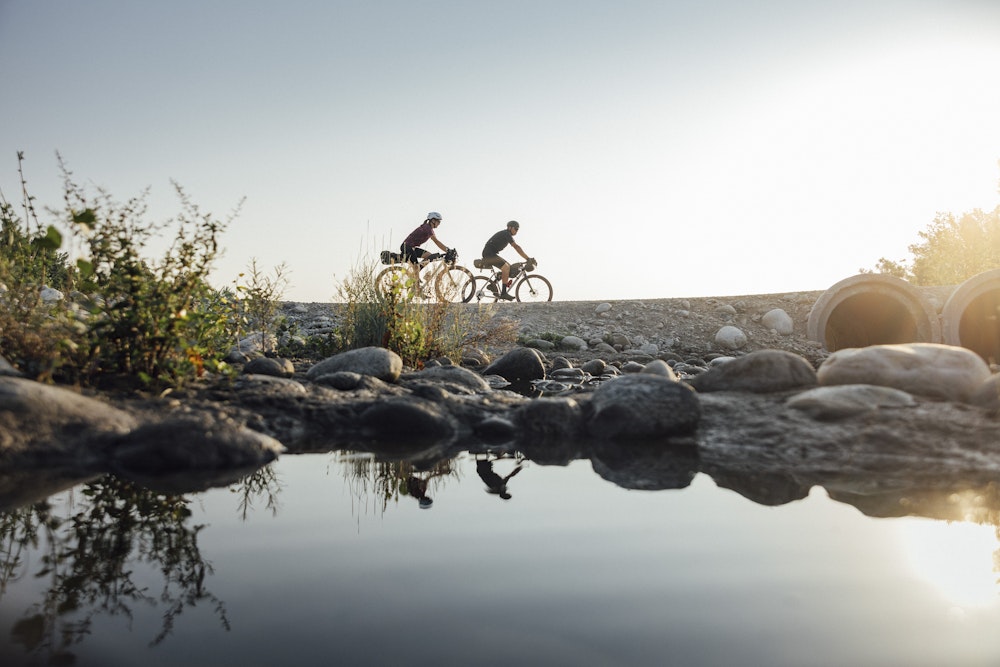
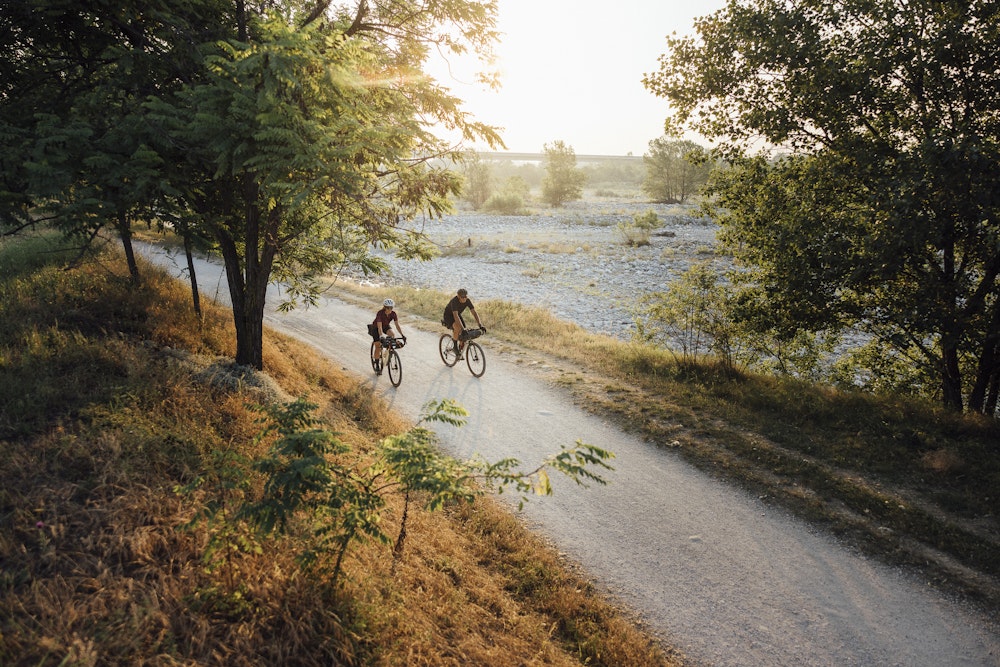
The surface towards the Foro Frumentario is cobblestoned, and the effect for us cyclists is that of a massage. This is where the Fausto Coppi International Gran Fondo passes through, and it is inevitable that we look up towards the legendary climbs of the Fauniera Pass and the Madonna del Colletto (even though it’s lunchtime and we have a plate of ravioli and a glass of Barbera in front of us). But it’s true that in these parts cuisine and the landscape go hand in hand.
In the afternoon, the shaded roads come to our rescue during the hottest hours. We have to reach Bernezzo, then Cervasca and finally San Maurizio. At the top of the climb, the Sanctuary awaits us. Leaning our bicycles against the wall and having a chat while sitting on the steps of the church is a welcome moment of calm. On our return to Cuneo, we cross the countryside again and capture the smells and sounds that had inspired our journey at the start of the day, now transformed by the light of dusk.
The next morning we discover that the sun from the day before has seared the hemlines of our jerseys and shorts onto our skin. We leave the town along Viale degli Angeli, named after the Sanctuary, and from the eastern side of the ridge we see the flowing waters of the Gesso and Bisalta rivers. Along the banks, fields of golden wheat fade in the dawn light. The road snakes between the walls of corn and the green channels of water. We depart from the Ferro da stiro — flat iron — of Cuneo, wedged and elongated between the Gesso and the Stura rivers, and pedal towards Borgo San Dalmazzo, a place that pays homage to the past; home to the Memo4345 Museum and the deportation memorial.
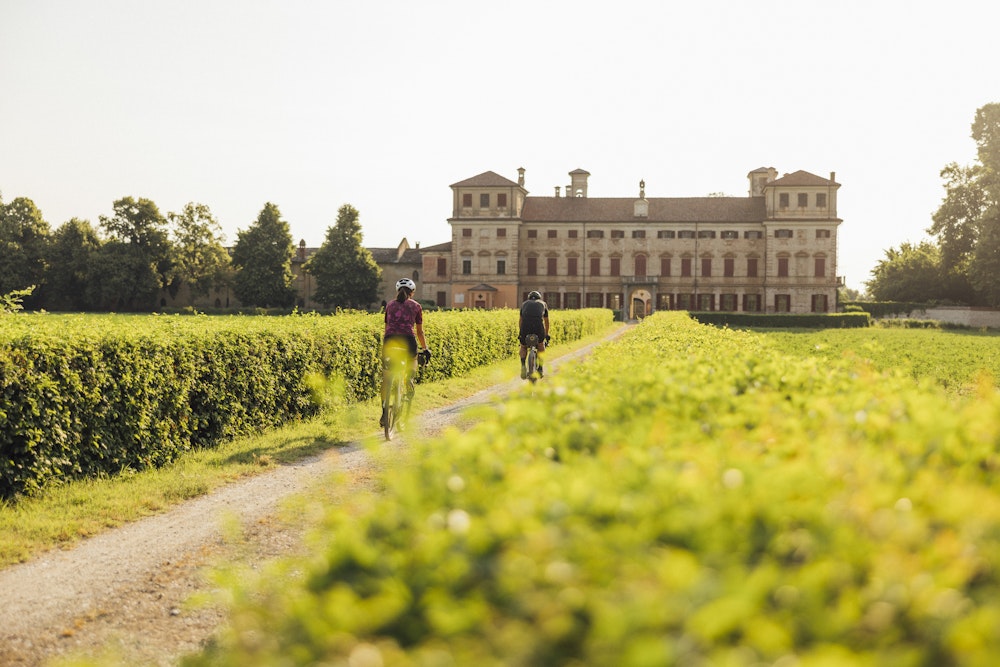
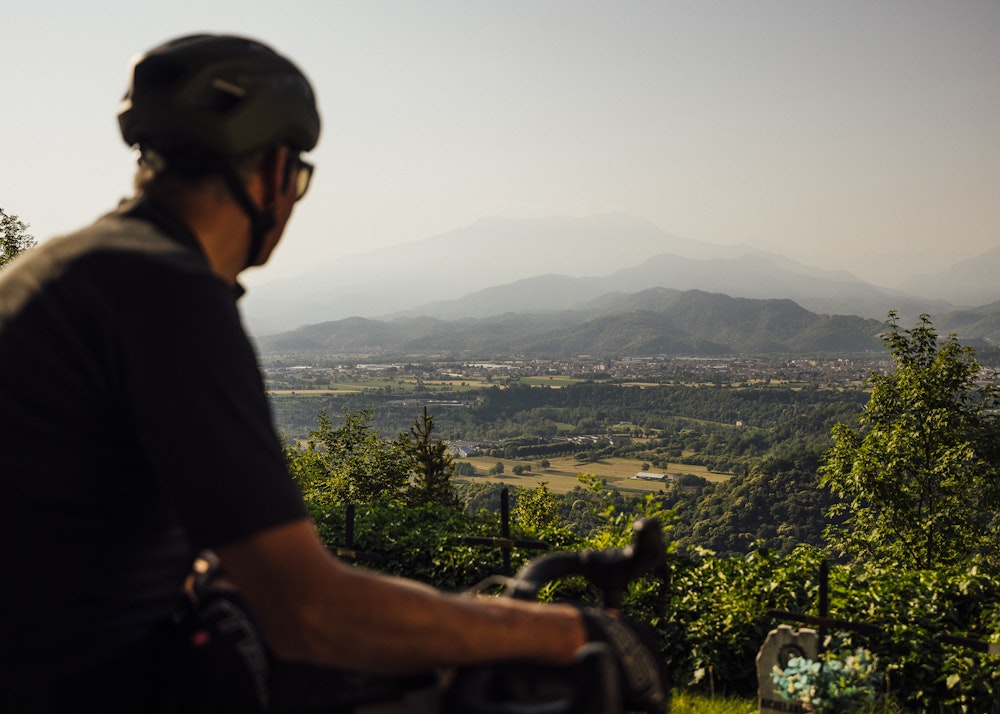
Memory also serves as a reminder not to overdo it, as the day is still long and it is only the first ascent of the route.
Pushing on the pedals, we head towards Roccasparvera. We’re welcomed by the coolness of the chestnut woods, among which we can distinguish the first yellow splashes of flowering buds. In front of us stands Porta Bolleris, the ancient 15th century tower in which goods were stored before transportation to and from France. At Rittana, a sign leading to the ridge that divides the Stura and Grana valleys says ’Paraloup’, the name of the hamlet that recalls the partisan war and recalls the writer Nuto Revelli.
The heat now feels distant — the stone with which these hamlets are made seems to have preserved a cool winter chill on our behalf.These are the ideal places to escape the sun, but when climbing these roads it is always advisable to carry a windproof jacket. A military road from Festiona, surrounded by the river and the mountain, goes to Madonna del Colletto. It’s six kilometres long, and perfectly still. Between the silence of the beech trees and the ticking of our freehubs, we hear the scamper of retreating fauna. The view from the summit seems to entwine the Gesso and the Stura. As ever after a hard effort, the landscape reveals itself in all its splendor.
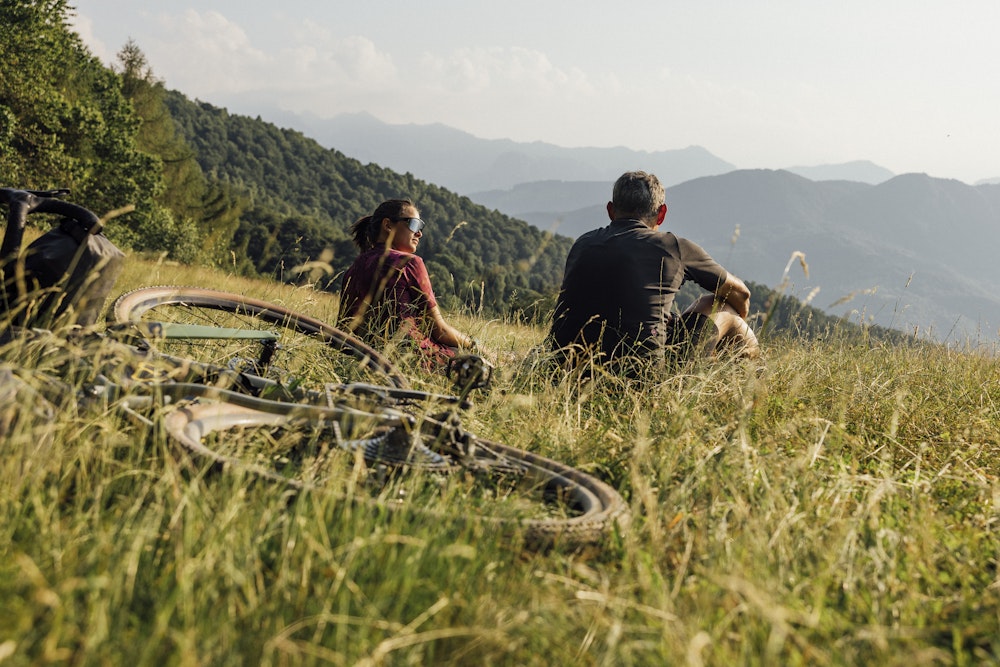
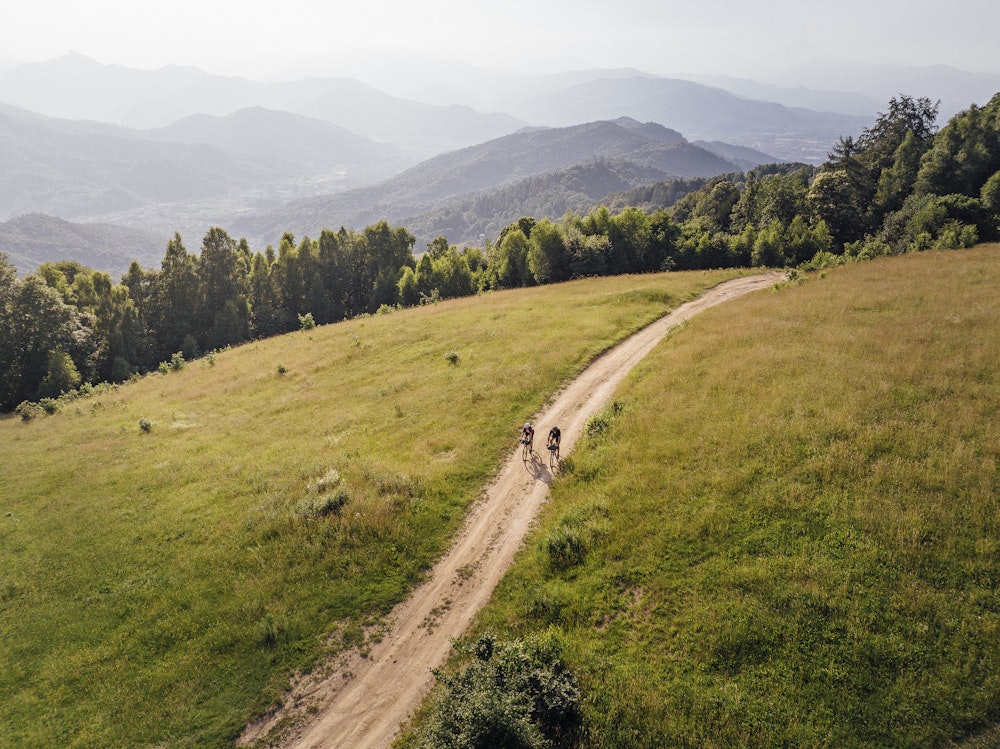
We take a moment to eat something and then descend, making sure to spin our legs as another climb awaits us in Valdieri. This is the one to Sant’Anna di Valdieri, a most unusual village in just about every respect. A decade or so ago it made headlines for having been revitalised by six women. Thanks to their initiative and entrepreneurial courage, it’s inns, apartments, holiday homes, taverns and craft workshops are living, breathing example of how to create intelligent and sensitive tourist accommodation. In resurrecting ancient values and reviving lost traditions, they’ve performed a small latter-day miracle. The ’mountain of yesteryear’ is among these houses.
Up there, we catch a glimpse of Terme di Valdieri. The rock walls narrow the road as the gradient begins to grip. Reaching the top comes with a sigh of relief. The taste of this place? A good plate of rye flour pasta topped with anchovies (nearby there is a museum dedicated to rye cultivation). Here, suspended between nature and the sky, we’ll pass an afternoon. We may very well visit the open-air Museum of Mountaineering, before sunset and a restful night in Sant’Anna. As night falls, fatigue is replaced by wonder, and a sense of the majesty and beauty of this place.
If you know that the first pedal strokes of the day are downhill, the morning alarm feels less daunting. With just enough time to check the bikes, we set off, taking care to layer up properly since the air is brisk at dawn. We arrive at Entracque, which lies in the sun-drenched basin between the waters of three streams and their dam. Its name aside, the town’s link with water is manifest. There are fountains – any number of them - scattered hither and thither. There is also a wildlife centre dedicated to the protection of wolves. Climbing to the top of the centre’s observation tower, you can admire the entire valley. Returning down the winding road to the small shepherd’s village of Roaschia is sheer fun. From here we climb up the Goderie pass. We ride through thick vegetation, and at the end of the flat, dirt road, furrowed by a few rivulets of water, we get a taste for cyclo-cross.
A technical descent takes us to Vernante. The village is inextricably linked to Attilio Mussino, one of the most famous Pinocchio illustrators. That would explain why the facades of the houses are full of puppets and whales; murals dedicated to the memory and work of Mussino. Time for a refill of croissants and a cappuccino at the café before we head to Robilante, where there is an Accordion Museum. When was the last time we heard an accordion playing?
We ruminate on that as we reach the climb of Malandre. Our breath is as short as the gradients are steep, and we still have the Goderie in our legs. As we stop to catch our breath, a passer-by offers a crumb of comfort. At the 1977 Giro del Piemonte, he informs us, even the professionals were seen to climb off here.
The climb isn’t done with us just yet, however. It continues, unpaved, towards Tetti Luchinet, and becomes increasingly rugged. The effort is rewarded by the wonder that awaits us at Pra du Soi.
When the forest opens up, it enchants us; from the large meadow one can admire, as if from the stalls of a theatre, the great mountains of the Cuneo region. It’s a sublime monument of rocks and sky. This colosseum of nature is no less than an invitation. To park our bikes on the grass, to be immersed in calm, to gaze in wonder at the profiles of the peaks. Tonight we will dine and sleep down in Rosbella, cooled by a few houses and a couple of fountains. In 2000 only one inhabitant resided here, but today there are 15. The sense of tranquility, though, is unchanged. The only noise in the village, when everyone goes to sleep, is the trickling water of the stream.
Once more the morning begins with a descent, though this one calls for caution. The dive down to San Giacomo di Boves is fast and technical, and good bike handling skills are a prerequisite. It almost feels like a launchpad into the next climb of Colletta Rivoira, which although short is one of those efforts that remains in your muscles to make itself felt when you least expect it. Towards San Giovenale we face a mixture of rolling peaks with a few stretches of dirt road; here a gravel bike is ideal.
We proceed towards Certosa di Pesio. It is mid-morning and the monastery is concealed between the sun and shade. Someone outside is tending to the flowerpots and the lawn as we sit under the porch, observing in silence. Along the staircase leading to the upper floors, we notice an ancient, painted map of Cuneo and its surroundings. We see some of the places we’ve been and feel as if we’re there again. We get our bearings and realise where we will be shortly. We eat a sandwich on the wooden tables outside the Certosa; all around are fir forests and the walls of the Punta Marguareis, towering 2,561 metres high.
We set off again towards Pian delle Gorre; more ascending, more gravel, more dense vegetation. The summit plays hide-and-seek after each bend — you imagine it revealing itself in front of you, but instead it’s always a little further on. When finally we reach it, we feast on an exquisite plate of gnocchi. After some rest, we descend, passing by the Certosa towards Mondovì. The town square is a pleasant stop. For those who want to go even higher, there are the 87 steps and 29 metres of the Belvedere Civic Tower; from here it feels as if we’re offering one final embrace, from the Langhe to the Cottian Alps, to the land we’ve crossed over the last few days.
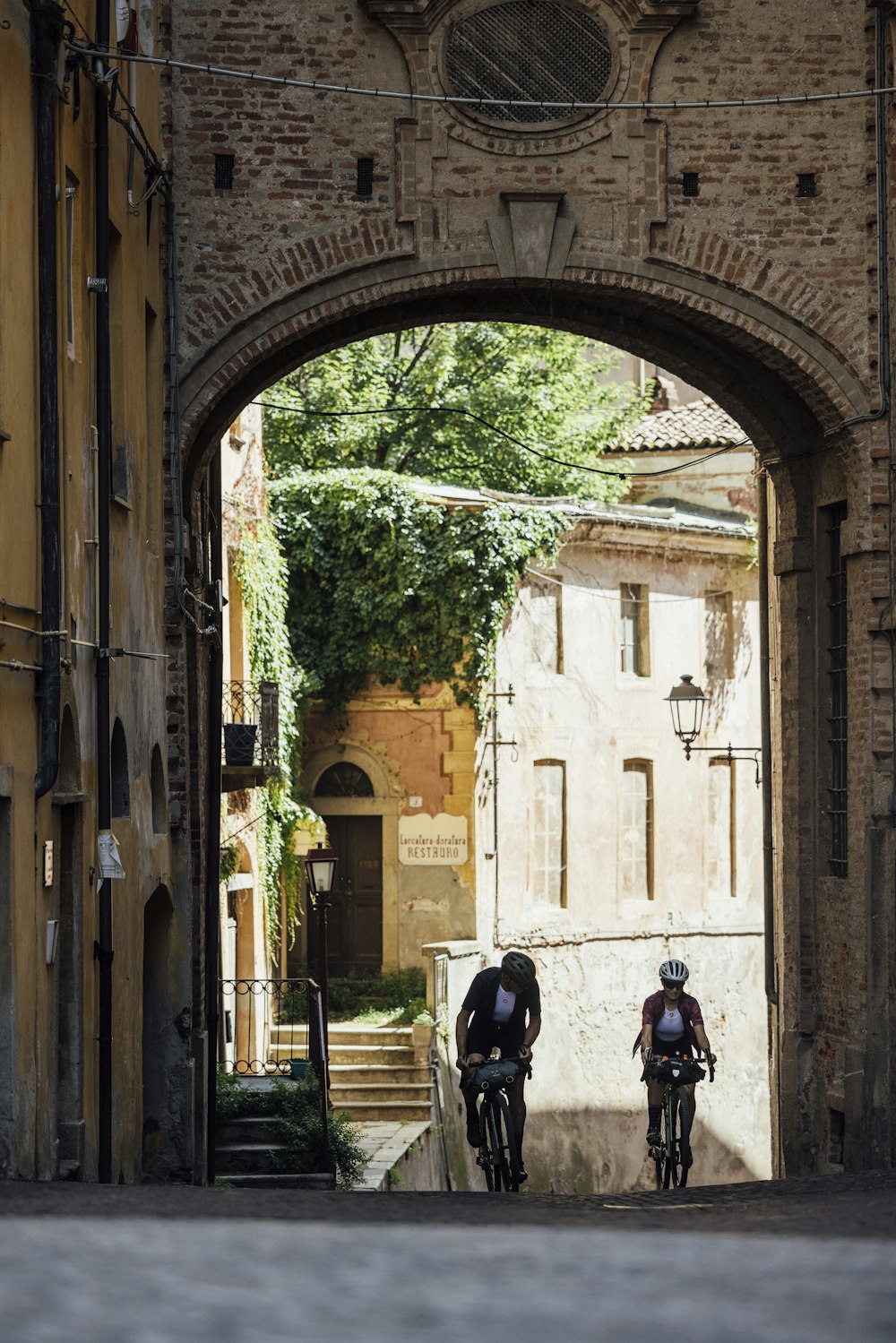
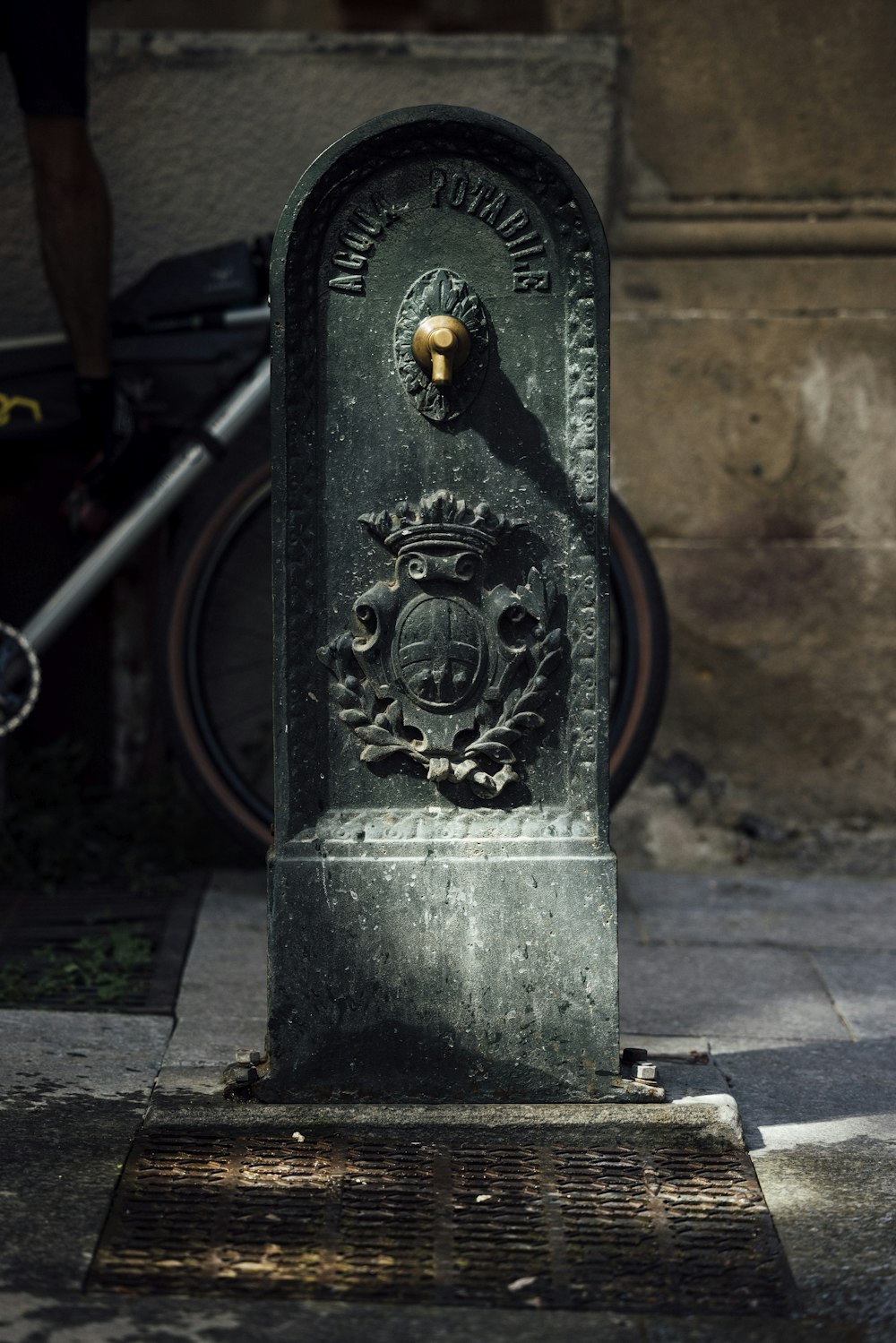
Returning towards Cuneo in the late afternoon, we pass the castle of Rocca de’ Baldi and the Crava-Morozzo Oasis, within which runs the short course of the Pesio river. Its source is located on the slopes of the Marguareis, in the Ligurian Alps, and after just 50 kilometres flows into the Tanaro near Carrù. The reserve is home to herons and ducks, and further on the small artificial lakes of Tetto Lupo are the last suggestion of wilderness before we reach our final destination.
The people of Cuneo say that whenever they leave their town, they cast a glance towards Monviso. They say it helps them feel at home for a little while longer, and so it is with us tonight. As we return to base base, we can’t help but gaze upon it as if searching for something. For guidance, maybe, as we approach the end of our journey.
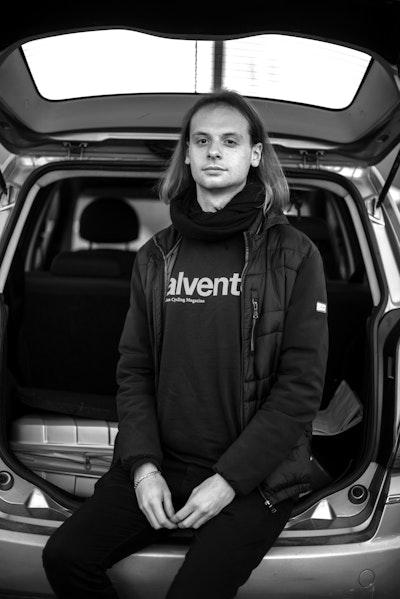
Texts
Stefano Zago
Photos
Daniele Molineris
Cycled with us
Alice Pellegrino, Erik Rolando
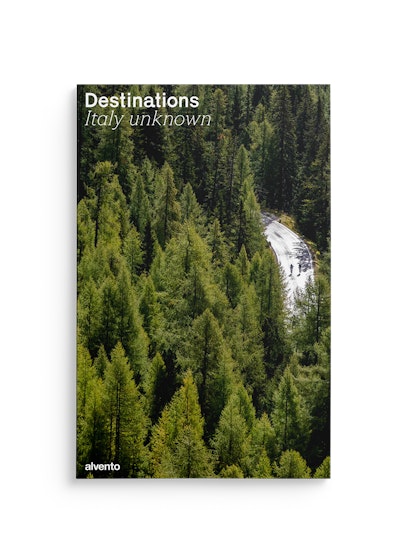
This tour can be found in the super-magazine Destinations - Italy unknown / 1, the special issue of alvento dedicated to bikepacking. 13 little-trodden destinations or reinterpretations of famous cycling destinations.
